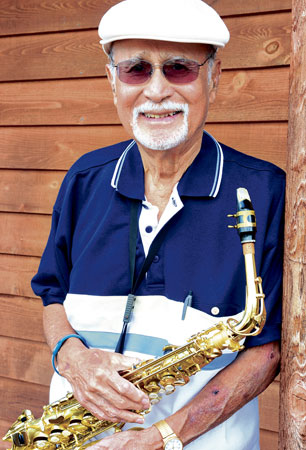Gabe Baltazar

Gabe Baltazar. Nathalie Walker photo nwalker@midweek.com
Jazz music is not constrained, it is not caged. There is no ceiling to a music style that embodies creative freedom for both the player and listener. Jazz branches off and incorporates different styles of music and creates many styles of its own – one being the get-up-and-dance pulse of swing music.
Local jazz legend Gabe Baltazar Jr. wrote about swing music in his recent book, If It Swings, It’s Music: “Something that makes you tap your foot, feel good … and snap your fingers. It makes you – automatic – get up and move around a little bit. It’s a state of mind, too.”
Baltazar epitomizes the Hawaii melting pot of the early plantation days of the 1920s and ’30s. His mother, Leatrice Chiyoko, was Japanese, his father, Gabe Baltazar Sr., was Filipino. Baltazar Sr. was a musician, and from a young age Baltazar Jr., who grew up in the Kalihi-Palama area, found himself at dance halls listening to his father’s music and absorbing the atmosphere.
As he saw the easy, free attitudes of dance halls, Baltazar also was raised by his mother’s parents, a much more rigid and traditional upbringing. He even attended a Japanese school after his regular schooling.
A bright, intelligent child, Baltazar’s first instrument was a clarinet his father bought for him and taught him how to play.
“Jazz music always excited me. I used to go down to jam sessions or rehearsals with my dad often. I kept on playing in high school,” says Baltazar, who was featured on MidWeek‘s cover July 11, 2001.
After winning a music contest, he headed to the famous Interlochen music camp for aspiring young musicians.
“Everywhere I went I always found the other jazz players. I found three or four at Interlochen, and we would jam,” says Baltazar, who after graduating from McKinley High School, attended Peabody Institute, a renowned music conservatory in Baltimore.
It was on the East Coast where Baltazar’s profession as a musician rose. He immersed himself in the jazz community, playing small gigs here and there for extra cash. He also got a chance to meet one of his role models.
“Charlie Parker was my biggest icon. Even today I love his music. I met him in New York. I would commute once in awhile to hear Charlie Parker and other great musicians like Dizzy Gillespie and so forth,” he says.
Baltazar traveled to venues and concert halls around the country during his time with the Stan Kenton Orchestra, playing mostly as an alto saxophonist. Regarded as a phenomenal soloist, Baltazar would bounce around, playing back and forth between the Mainland and Hawaii.
With a career that stretches safely over 50 years, Baltazar linked up with old friend and musician Theo Garneau, who was working on his doctoral degree at UH-Manoa and wanted to feature Baltazar as the centerpiece of his dissertation. The dissertation evolved into a complete autobiography of Baltazar’s career and experience as a jazz musician.
“Jazz is a part of me,” says Baltazar. “I wanted to be a cartoonist in high school, maybe work for Disney, but music and jazz overtook me and I decided that’s where I wanted to be.”





